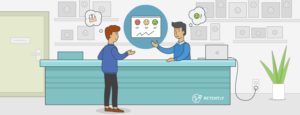While customer satisfaction plays a pivotal role in assessing the future growth trajectory of a company, the truth is that collecting customer feedback is a tricky and lengthy process. Most businesses simply don’t have a framework that could proactively obtain key insights and engage with customers in real-time.
In my previous posts, I talked about how NPS can be used as the ultimate growth hacking metric, and how NPS feedback can be used to proactively close feedback loops.
BUT, let’s get real.
When you have thousands of customers, closing the feedback loop with every customer becomes an uneconomical, unscalable and time-consuming process.
That’s where automation comes in.
Companies that excel in automating customer intelligence generate 50% sales-ready leads at 33% lower customer acquisition costs. And it’s not just about reducing acquisition costs. According to Nucleus Research, automation drives a 14.5% increase in sales and a 12.2% reduction in marketing overhead. In fact, it’s being used by 79% of the top-performing companies and remains one of the key competitive differentiators.
In this article, we’re going to explore how Mention — the powerful media monitoring platform — managed to streamline its NPS data collection process by integrating standalone services with automation suites.
The end result was a fully automated NPS framework that was capable of interacting with customers at different points of the customer lifecycle journey and re-engaging them on a consistent basis, with little to zero human intervention.
Automating the process had a big impact on Mention’s bottom-line margins, as it managed to reduce churn by half and triple the total number of upgrades in just a span of two months.
Not bad for an experiential automation setup, right?
So, how did they do it? Let’s take a look at Mention’s quick and dirty NPS-MVP setup.
Problem Statement: Capture Qualitative Feedback from Customers
Despite having a highly engaging product that fetched a large number of daily signups, the problem for Mention was that they had little visibility into who their customers were, and whether they really liked their product.
For instance, Mention had no idea what stopped active customers on the free trial plan from upgrading to a premium plan? Or what prevented newly signed up users from coming back after they used Mention a few times?
As there was no credible way to assess the quality of customer interactions, it became almost impossible to understand what can be done to improve the product experience. That’s what motivated Guillaume Cabane, Head of Marketing at Mention, to create a framework that would capture qualitative feedback from their customers.
Guillaume chose to use NPS surveys for capturing qualitative feedback as they were non-intrusive and quick. NPS surveys could be completed by customers in less than a minute. The underlying simplicity of the NPS framework is also one of the prime reasons why it manages to get a higher survey response rate.
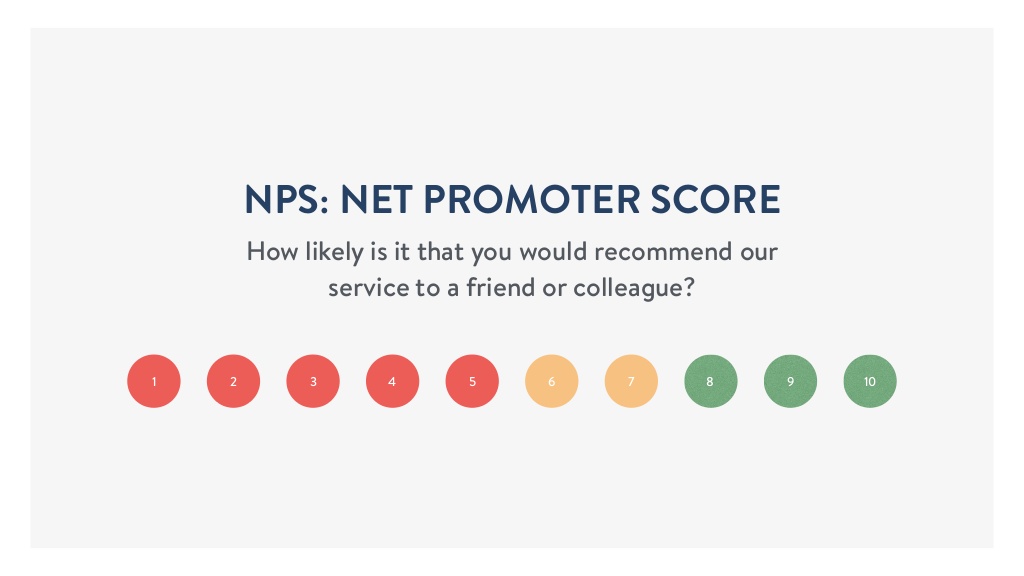
What makes NPS a good choice?
Apart from the simplicity of the metric and its relatively wider outreach, there were two prime considerations for choosing NPS to qualitative feedback:
- Correlation analysis: As NPS is a single metric that measures overall brand sentiment, it could be mapped with growth, financial or management KPIs to understand how overall customer satisfaction impacts the business performance.
For instance, individual LTR (likelihood-to-recommend) scores could be tracked across the customer journey to understand how product decisions impact customer satisfaction. As correlation analysis uses data to analyze customer behavior and measure outcomes, it proves to be a much better product enhancement strategy than relying on intuition or “gut-feeling”.
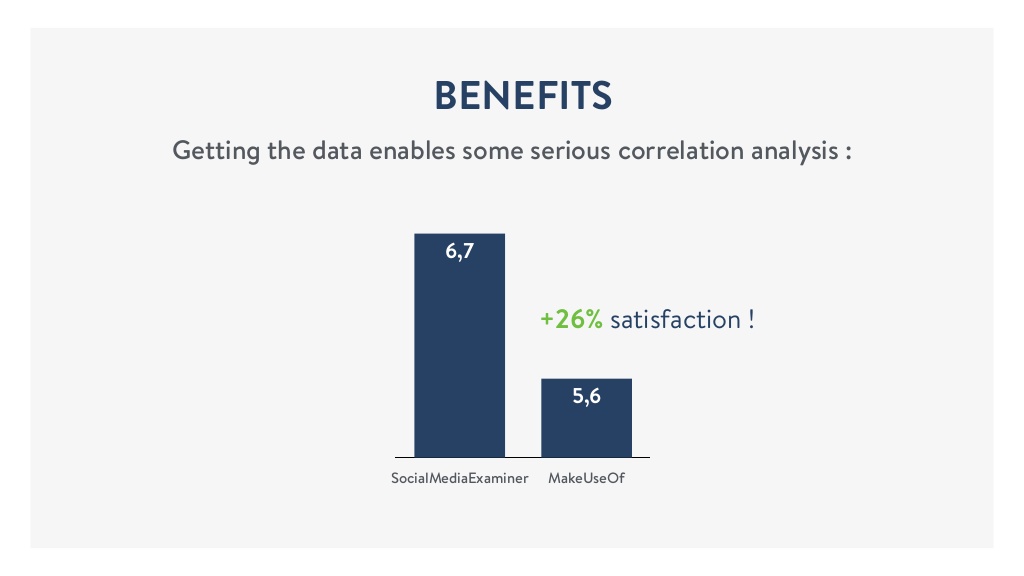
- Open-ended feedback:
Unlike most of the traditional customer satisfaction surveys which have a predefined set of responses, NPS allowed Mention to capture honest, open-ended feedback. While NPS has been criticized for being culturally insensitive or having low predictive validity, the truth is that Mention didn’t really care about the score.
For Guillaume and his team, NPS was just an excuse to engage customers into more specific questions. To them, it didn’t matter whether they had a higher NPS score than their competitors or if they beat the industrial average. Instead, they were more interested in using the captured NPS insights to reduce customer churn and boost revenue.
Setting up the initial NPS workflow
The initial NPS workflow that Mention setup for capturing qualitative feedback from their customers was pretty simple. Here’s what they did to get their flywheel moving:
1) Creating the NPS survey
Mention chose to use emails for sending out NPS surveys as they were non-intrusive and can be sent to a larger set of customers (even those who don’t actively use their product!). They personalized their survey template with the name of the customer and attached a unique trackable link to the NPS measurement scale.
Whenever the user clicked on a score in the email, the value would first be recorded in the integrated KissMetrics analytics platform, following which the user would be redirected to Mention’s website for answering and submitting the response to the follow-up question.
The reason why Mention records the score even before the customer submits the survey is because Click-through rates (CTR) are generally higher than survey completion rates. So, even if the user chose not to answer the feedback question and submit the survey, Mention would still be able to retain their NPS.
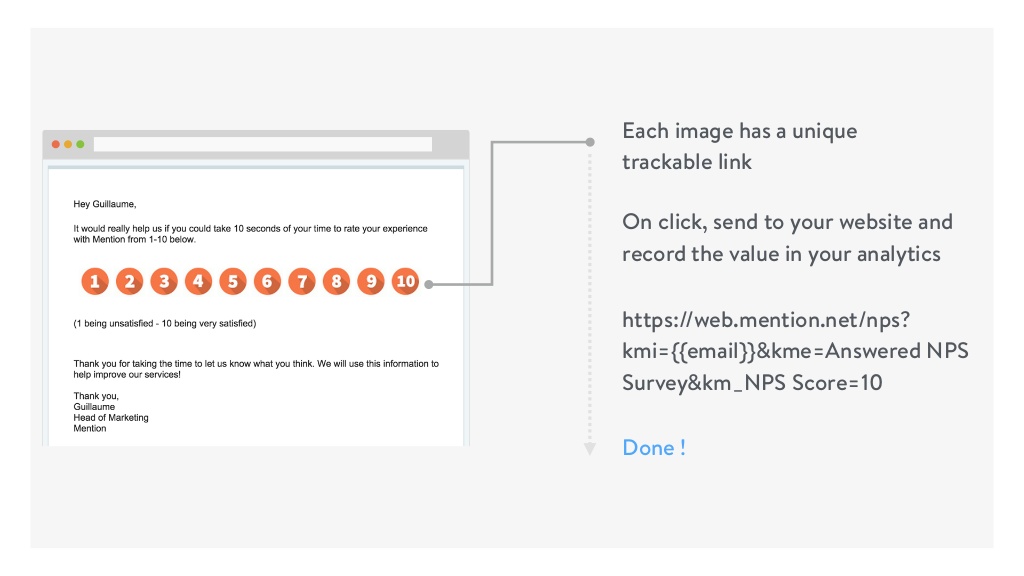
2) Getting the timing right
Surveys are all about timing. Sensing the importance of timing, Mention triggers NPS surveys at critical milestones in the customer lifecycle.
For instance, Mention knows that it would make no sense to ask customers, who just recently signed up on their platform to answer whether they would recommend their service to their friends (they just don’t know it yet!).
But, if a customer signed up for a free trial but decided to discontinue after the trial period, it’s an indicator of a strong customer interest, albeit weak product engagement. Maybe, they were unimpressed by the overall product experience. Maybe, they found the pricing to be too inconvenient, or maybe, they forgot about the service altogether.
Considering the fact that most customers have little incentive to come back after the free trial period has ended, Mention sent the NPS survey to all of the customers one day after their free trial has expired. It was a great opportunity to interact with these customers, and re-engage them before they churn.
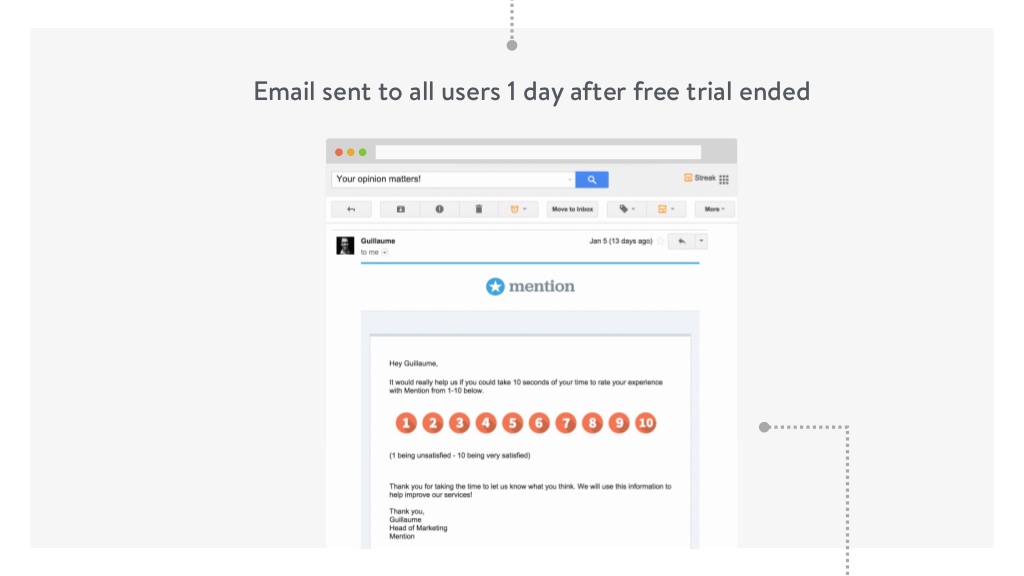
3) Linking it up with Google Forms and Kissmetrics
After customers leave their feedback and submit the survey, Mention redirects them to a “Thank you” page and logs their entries in a Google Drive sheet. While Mention used Zapier to integrate these two services, this can also be done by writing a simple Google script and using the API functions to log the score value and feedback.
Here’s an example of how the URL actually looks like.
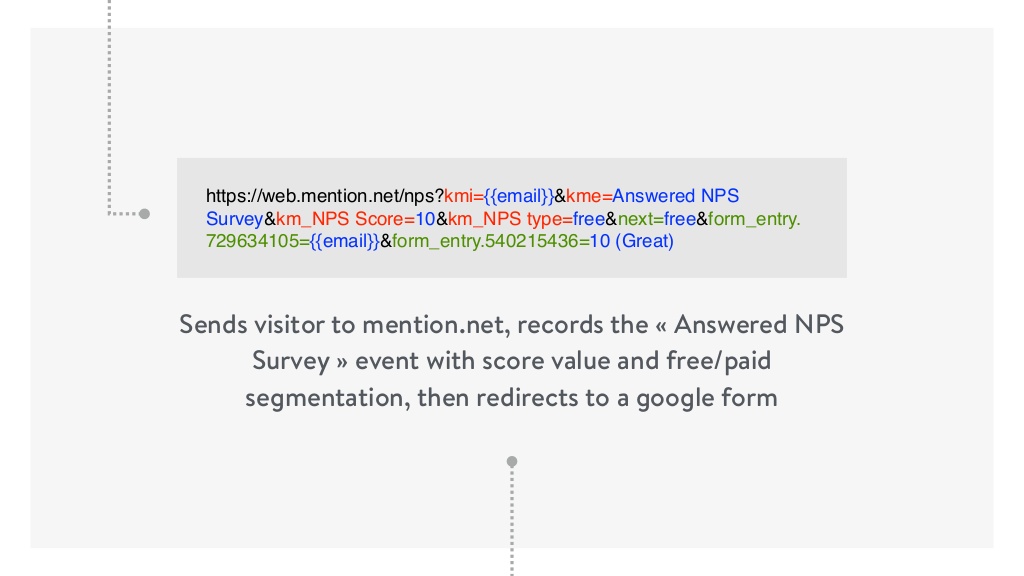
As you might notice, all the captured values are passed as parameters in the URL, which are then passed on KissMetrics and Google Forms for data capturing. In order to better understand the behavior of customers, Mention also records the plan of the customer is subscribed to (Free or Paid) along with their individual feedback.
Segmenting responses play a pivotal role in assessing whether paid customers are, in general, happier than free customers, and how their customer satisfaction levels vary over different product milestones (post free trial, post first billing cycle, etc.)
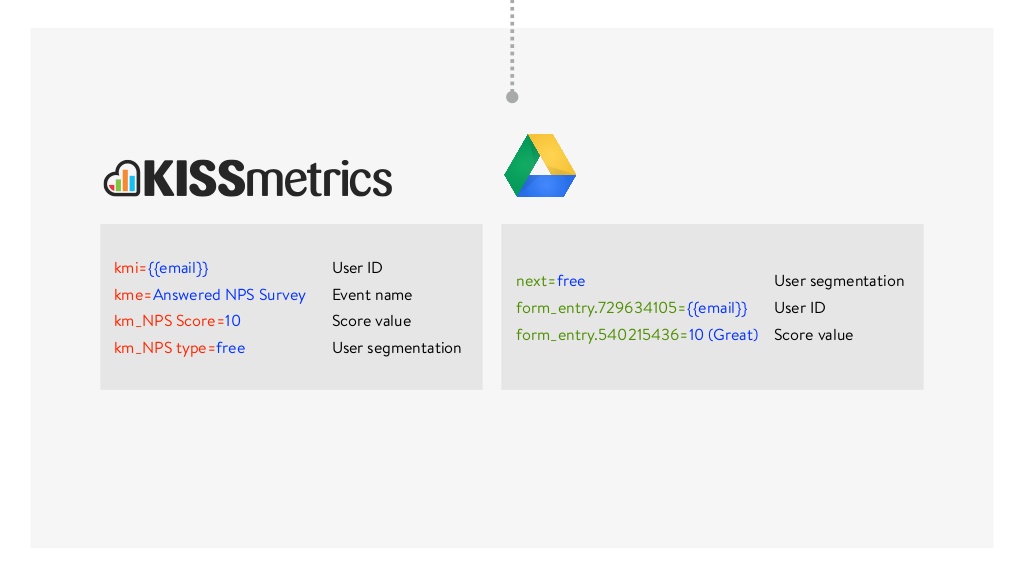
4) Re-engaging customers
After capturing responses from the survey, Mention divided customers into three segments, based on their score:
- Promoters: 9-10 [Customers who loved Mention and would happily recommend it]
- Passives: 7-8 [Customers who think Mention could be better]
- Detractors: 0-6 [Customers who have serious problems with Mention]
Until this point, the entire process was essentially automated using tools like Kissmetrics or Google Forms, but for proactively reaching out to customers, Mention decided to use a combination of personalized email templates and strong incentives.
For instance, if a customer gave a score of 9-10 after the trial period had ended, it was a strong indication that they were interested in the product, but were reluctant to upgrade. Mention reached out to these customers and gave them a discount on an upgrade, offering them a strong incentive to shift gears.
Similarly, if a customer gave a score of 7-8, Mention reached out to these customers and extended their free trial. These customers could use the product for a few more days, and decide whether it’s a good fit for them. Although it was a relatively small gesture, it showed customers that Mention was actively listening to their feedback and was committed to delivering customer success.
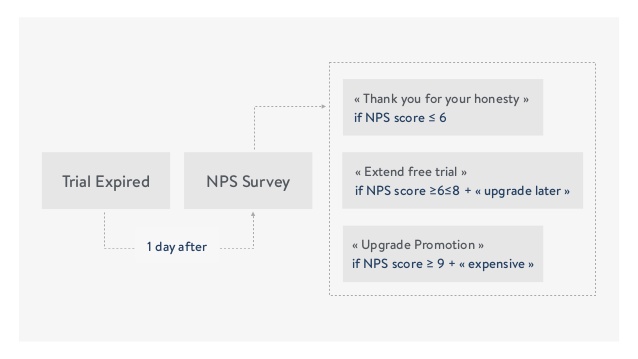
5) Closing the Feedback loop
While Mention managed to semi-automate the process of reaching out to promoters or passives by offering them incentives, there was one customer segment that needed their highest attention – Detractors.
Detractors were unwilling to pay, even if the upgrade was heavily incentivized. Since these customers had the highest probability of churning, Mention decided to reach out personally to each one of them and understand what were the main factors causing their dissatisfaction.
For instance, instead of directly offering any incentives, Mention asked detractors to share their honest feedback on why they were not willing to upgrade. The plan was to listen to their problems and provide a viable solution. Here’s an example of the email that they sent:
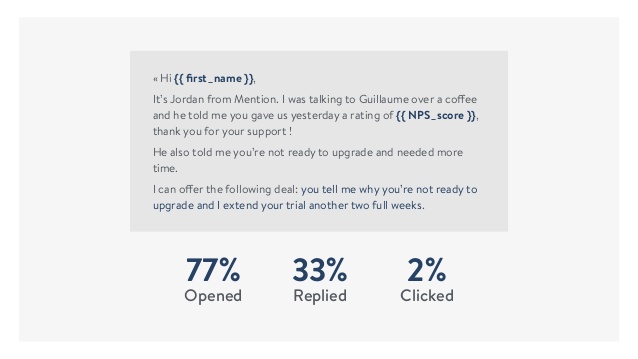
Despite the fact that detractors have the lowest brand affinity, the email was opened by a staggering 77% customers, out of which 33% took the time to actually respond to the email, while only 2% clicked on the deal.
As a result of the proactive outreach, Mention captured detailed insights into key customer problems and successfully managed to engage them in detailed one-to-one conversations.
Results: Upgrades Boost over 250%
Mention ran the NPS experiment for a period of three months and the results were truly phenomenal. After three months, the cumulated number of upgrades from NPS respondents was 3.5x times higher than the average upgrade rate.
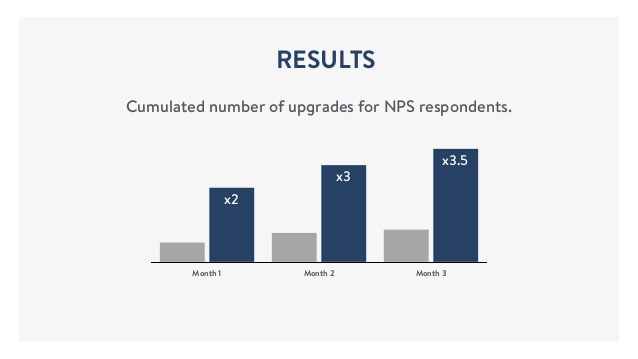
They also managed to reduce their churn rate by half, as they were now preventing customers from switching to competitors by proactively closing the feedback loop.
The sweet combination of increasing the bottom-line margins by 250% and cutting down the churn rate by nearly 50% made automating NPS an extremely profitable growth hack for Mention!
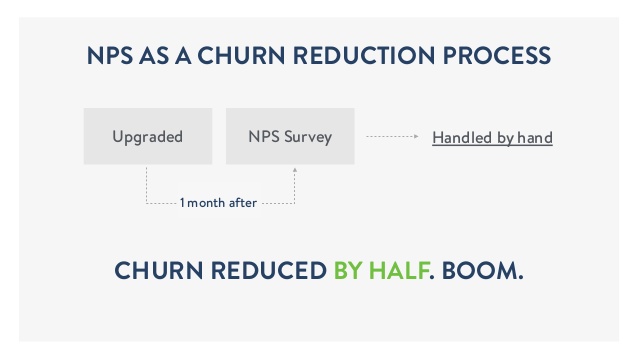
But there was still one problem. Despite the amazing results, they had some serious issues with the scalability of the campaign, as NPS responses were handled manually. On an average, it took nearly ten days to respond to a customer, which meant that they could not keep up with NPS at their growth rate. If Mention had to keep scaling their NPS campaign, their strategy had to change.
Automating NPS: Configuring the Cloud for Heavy Lifting
Mention figured out that the only unscalable element in their NPS framework was human interaction. Basically, if they could figure out a way to automate responses based on their individual feedback, they could reduce the response time.
So, just for a quick recap, here’s the initial NPS workflow that Mention conceptualized:
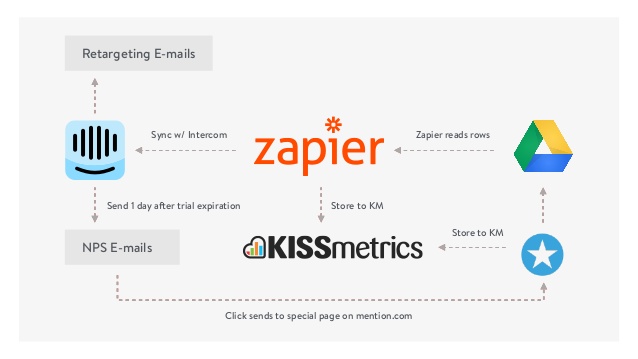
They linked three services with Zapier: Intercom (for sending emails), Kissmetrics (for recording NPS) and Google Sheets (for segmenting the feedback). As the workflow explains, Intercom automatically sent the NPS survey email one day after trial expiration.
However, the problem with the setup was that the data could not flow seamlessly into different silos. Also, it became difficult to optimize the NPS framework based on responses or log the individual score in the customer profile.
For instance, if Mention knew whether the customer was a promoter, passive or detractor when they raise a support ticket, they could optimize their response time and resolution to maximize customer satisfaction. So, here’s what they did to streamline the data flow:
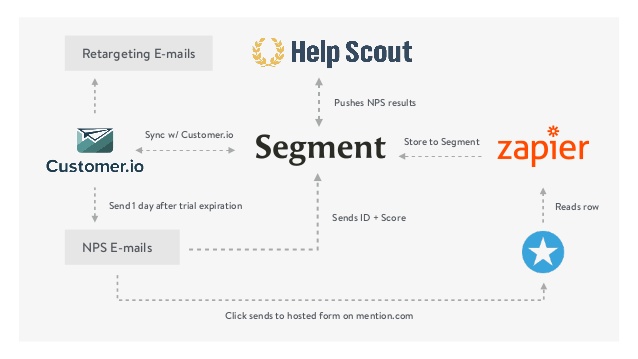
Instead of utilizing Kissmetrics, Mention integrated Segment, an analytics API, to record data from the other services they use. Segment was capable of capturing data from multiple touch points and pushing them to over 200+ services, it opened up the playground for NPS strategy optimization.
For instance, Mention could now sync NPS data with tools like Customer.io, so that customers are automatically re-engaged at different product milestones. Segment also pushed NPS data to helpdesk tools like HelpScout, allowing Mention to automatically create a support ticket for detractors.
In other words, the automated creation of feedback loops provided an easy way for customers to share their valuable feedback. The optimized workflow also gave more visibility to the customer support team, following which they were able to track customer problems, prioritize the important ones, and follow up with customers.
But, Mention did not stop here. They optimized their workflow even further by integrating a dedicated NPS product. The setup minimized redirects to the website, allowed Mention to personalize user experience and gave amazing results.
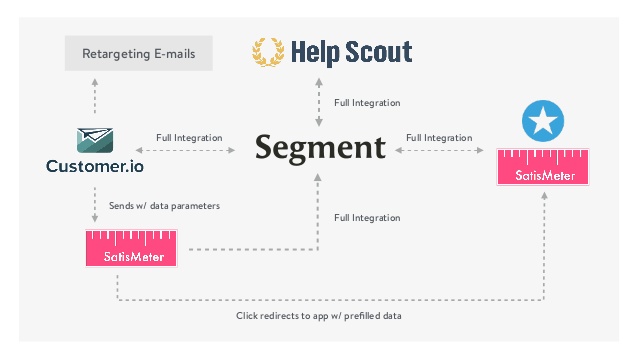
How to Improve Survey Response Rates?
The latest strategy Mention is currently using – displaying in-app surveys for 5 days, then sending a series of 2-3 emails (each having a 3-day delay) until the survey is filled by the customer. The advantage of doing in-app surveys first is that your customers have a fresher memory of how it feels to use your product, they can pinpoint your ups and downs immediately. And it also has a higher response rate that can go up to 70%. Email surveys are great at re-engaging users who have been recently inactive. They decided to do a combination of both to maximize the response rate.
Mention sends the survey to all users but with slightly different rules. As they did before, a personalized email is being sent to a specific category. Promoters might be getting an offer to upgrade and passives – extend a free trial or use a coupon.
This process is repeated every 3 months to check if their customers’ satisfaction has changed during all this time and measure it against the initial survey.
Net Promoter System proved to be very effective for Mention – increased customer satisfaction and reduced customer churn is a confirmation of that. That is probably the reason why they remain dedicated to NPS product until this day.
Multi-Tasking NPS: How Mention Uses Customer Feedback
By streamlining data flow using cloud services, Mention optimized the NPS workflow and managed to create a setup that was infinitely scalable. While the initial use of NPS was limited to increasing upgrades and reducing churn, Mention now uses the metric to keep track of the overall brand sentiment.
For instance, Mention now tracks NPS scores to measure how satisfied customers are with the product update. It also uses NPS to prioritize feature requests and refine the product roadmap. By proactively listening to customer feedback, Mention also took that first crucial step towards building a culture of customer success.
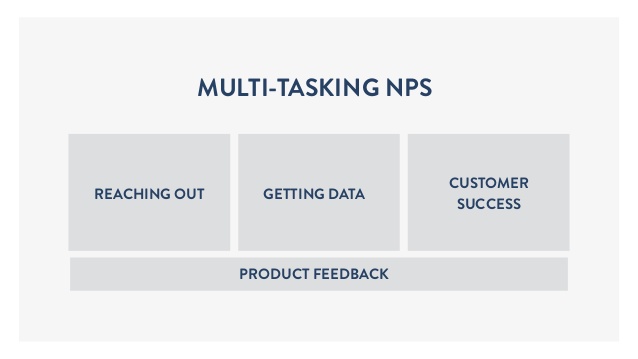
If we had to co-relate the original NPS setup Mention used with the hedgehog concept, we could draw some pretty neat parallels. While many solutions succeed in empowering businesses to optimize answer rate and handle qualitative feedback, automating the workflow is crucial to scaling the campaign to millions of customers.
Apart from scalability, marketing also provides infinite extensibility, allowing NPS data to flow into different organization silos and creating a unified metric for assessing customer satisfaction.
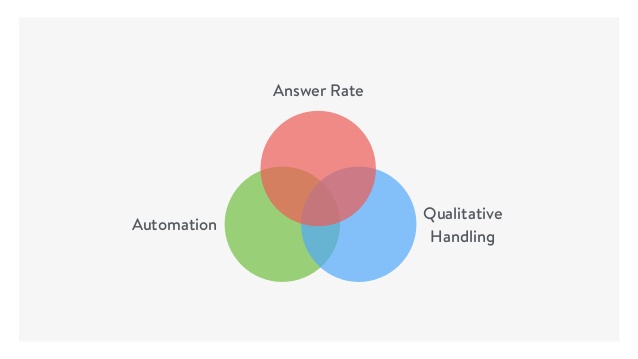
Automate Your NPS Workflow: The Easy Way
While early-stage startups can still run a semi-automated NPS setup, it’s quite evident from the Mention case study that investing in a complete NPS product can have a significant impact in boosting customer satisfaction. Not to mention, automating NPS also reduces operational overhead and resolution time.
The only potential downside to automating your NPS workflow is the significant time investment to get your setup up and running. But what if we told you could automate this process, without spending a hell lot of time in the configuration?
Ready to try it out?
Automate it with Retently. Our highly customizable NPS survey platform makes it easy to collect customer feedback, create workflows, and finally boost customer satisfaction. You can connect it to your favorite services like Intercom, MailChimp, HubSpot, Zapier, etc. Sign up for a 7 days free trial now.
Watch the Entire Presentation
You can catch the entire presentation here.




























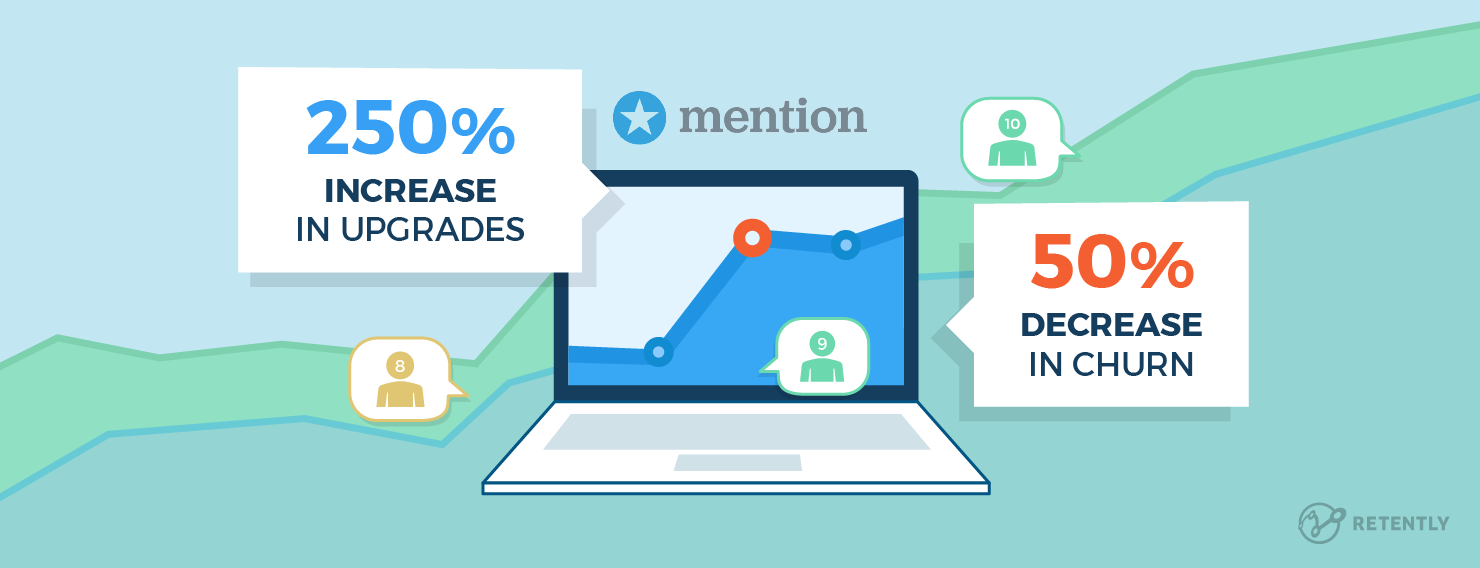






 Christina Sol
Christina Sol 
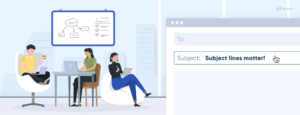
 Greg Raileanu
Greg Raileanu 
 Alex Bitca
Alex Bitca 
